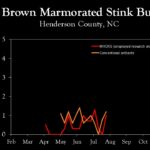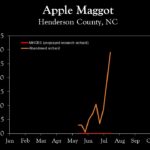WNC Orchard Insect Pest Populations – July 30, 2025
go.ncsu.edu/readext?1085391
en Español / em Português
El inglés es el idioma de control de esta página. En la medida en que haya algún conflicto entre la traducción al inglés y la traducción, el inglés prevalece.
Al hacer clic en el enlace de traducción se activa un servicio de traducción gratuito para convertir la página al español. Al igual que con cualquier traducción por Internet, la conversión no es sensible al contexto y puede que no traduzca el texto en su significado original. NC State Extension no garantiza la exactitud del texto traducido. Por favor, tenga en cuenta que algunas aplicaciones y/o servicios pueden no funcionar como se espera cuando se traducen.
Português
Inglês é o idioma de controle desta página. Na medida que haja algum conflito entre o texto original em Inglês e a tradução, o Inglês prevalece.
Ao clicar no link de tradução, um serviço gratuito de tradução será ativado para converter a página para o Português. Como em qualquer tradução pela internet, a conversão não é sensivel ao contexto e pode não ocorrer a tradução para o significado orginal. O serviço de Extensão da Carolina do Norte (NC State Extension) não garante a exatidão do texto traduzido. Por favor, observe que algumas funções ou serviços podem não funcionar como esperado após a tradução.
English
English is the controlling language of this page. To the extent there is any conflict between the English text and the translation, English controls.
Clicking on the translation link activates a free translation service to convert the page to Spanish. As with any Internet translation, the conversion is not context-sensitive and may not translate the text to its original meaning. NC State Extension does not guarantee the accuracy of the translated text. Please note that some applications and/or services may not function as expected when translated.
Collapse ▲ As August approaches, apple insect activity continues to pick up. Although many orchards still have low pest pressure, codling moth, oriental fruit moth (OFM), apple maggot and brown marmorated stink bug (BMSB) can all be found in one place or another. Some of these locations historically have high numbers of one or more pests, and reduced insecticide inputs due to poor crop loads or early season hail damage have contributed to increased pressure at other locations. If an orchard falls in these categories, or is adjacent to one that does, monitoring is especially important.
As August approaches, apple insect activity continues to pick up. Although many orchards still have low pest pressure, codling moth, oriental fruit moth (OFM), apple maggot and brown marmorated stink bug (BMSB) can all be found in one place or another. Some of these locations historically have high numbers of one or more pests, and reduced insecticide inputs due to poor crop loads or early season hail damage have contributed to increased pressure at other locations. If an orchard falls in these categories, or is adjacent to one that does, monitoring is especially important.
Codling Moth and OFM: In Henderson County we are nearing the end of second generation codling moth egg hatch (about 2000 degree days (DD), equivalent to 92% egg hatch complete), and continued adult captures in pheromone traps suggest third generation adults are emerging. While populations have been low in many locations, significant damage was recently observed in a couple of orchards. In most situations infested fruits include both codling moth and OFM larvae. Trap captures of both pests have been relatively high in orchards with low insecticide inputs, so both can remain a threat depending on location.
BMSB. As of July 30, cumulative BMSB degree-day accumulations are 766, indicating that about 6% of first generation adults have emerged. This is the earliest emergence of first generation BMSB adults in recent memory. While trap captures went up only slightly this week, they are expected to increase over the next several weeks. Trends over the past several years suggest that overall populations are declining in the region, but this can vary considerably among locations. Hence, on those cultivars most susceptible to BMSB damage, an insecticide should be considered within the next week or so.
Most pyrethroids will provide suppression of BMSB, but bifenthrin is the most effective. Note that Brigade and Bifenthrin are the only two formulations of bifenthrin registered on apples. The 2EC formulation has a wide rate range (2.6 to 12.8 fl oz/acre), but a rate of 6 to 9 ounces should be used for stink bugs. Note: Pyrethroids will also provide excellent control of OFM and apple maggot (see below).
Apple Maggot: Fly captures on traps have been non-existent at the Research Station in Mills River, but high numbers continue to be captured on traps at a commercial site not being managed this year, and which historically has captured flies. Monitoring with traps is clearly the best approach to making management decisions.
2025 Average Weekly Trap Captures
| HENDERSON COUNTY | |||
| Insects per trap | |||
| Jul 14 | Jul 21 | Jul 28 | |
| Codling moth | 1.0 | 1.0 | 0.5 |
| Oriental fruit moth | 16.5 | 17.0 | 10.0 |
| Tufted apple bud moth | 1.0 | 0.0 | 1.0 |
| Redbanded leafroller | 0.0 | 3.0 | 0.0 |
| Obliquebanded leafroller | 0.0 | 3.0 | 0.0 |
| Lesser appleworm | 4.0 | 0.0 | 0.0 |
| Apple maggot (unsprayed research orchards) | 0.0 | 0.0 | 0.0 |
| Apple maggot (abandoned orchard) | 8.5 | 19.0 | 29.0 |
| Brown marmorated stink bug (commercial orchards) | 0.0 | 0.8 | 1.2 |
| Brown marmorated stink bug (unsprayed research orchards) | 0.3 | 0.0 | 1.0 |
| Spotted tentiform leafminer | 0.0 | 0.0 | 0.0 |
| Dogwood borer | 34.0 | 16.0 | 33.0 |
| Peachtree borer | 21.5 | 23.5 | 15.0 |
| Lesser peachtree borer | 15.5 | 20.0 | 17.5 |
| San Jose scale | 1.3 | 1.3 | 0.0 |
*Note that these averages illustrate only the timing of insect emergence and fluctuations in populations, and are not representative of population levels in any given orchard. The only way to have an accurate assessment of an individual orchard’s populations is to set up traps in that orchard.
2025 Accumulated Degree Days
| HENDERSON COUNTY | ||||
| Jul 14 | Jul 21 | Jul 28 | ||
| Codling moth (Biofix: April 21) | 1568 | 1757 | 1944 | |
| Oriental fruit moth (Biofix: March 17) | 2359 | 2583 | 2799 | |
| Tufted apple bud moth (Biofix: April 14) | 2036 | 2261 | 2476 | |















